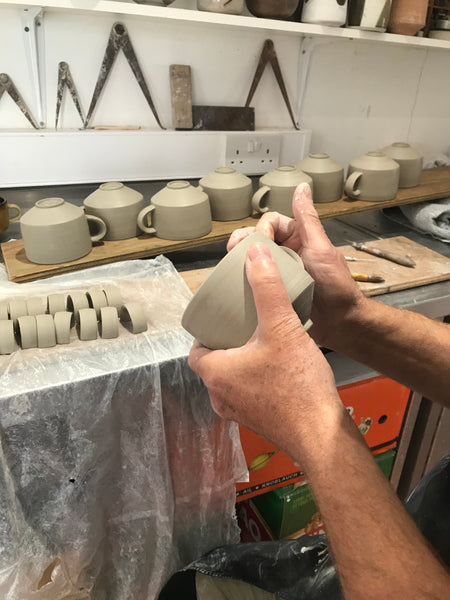
Annadale Brickworks - Clive Fiddis
Posted by Hannah Gumbrielle in: annadale brickworks, Belfast, Irish Ceramics, Irish Craft
Annadale Brickworks is a Belfast ceramics studio established by Clive Fiddis. The name derives from an old brickworks near to Clive's studio in the centre of Belfast. Having loved, made and taught ceramics in Ireland and Finland for 30 years, Clive is a master in his chosen craft. Simplicity of function and a passion for skillful making and craftsmanship are essential elements in all the work. Clive was kind enough to let us ask him a few questions about his making process.

Tell us a bit about what you make.
I make thrown functional pots. I'm very focused on the skillful making and material and firing process, simple form and function.
Could you describe your studio to us? What is your favourite thing about the space?
The studio is only a few years old, its very much an urban space in Belfast, it has two floors, a kiln room and is a very open plan flexible space with lovely light. I love its urban feel and the light quality.
How do you get into the mindset of making?
I tend to make in batches and like the rhythm of making, glazing and firing. There's always things to do in a studio, glaze and colour tests, tools, new work ideas.
What is your favourite tool and why?
I make my own tools if I can, my favourite is the knife I made out of a second hand buy.
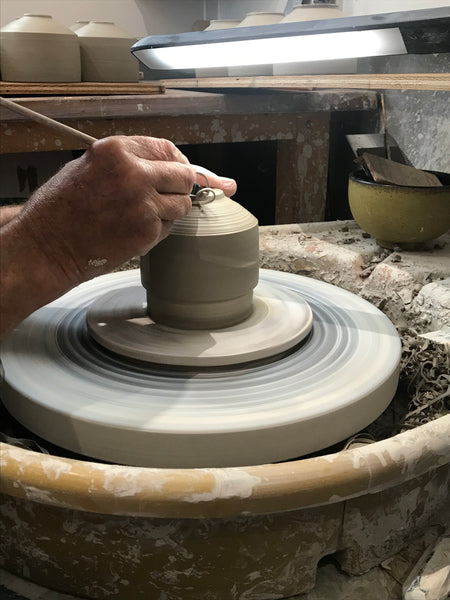
Can you describe your making process to us?
I throw nearly all of the pots on the wheel, usually in batches, using a simple stoneware clay. Pots are dried slowly, bases turned, handles attached and finished before firing. The pots are fired twice, glaze fired in a gas kiln at stoneware temperatures.
What is your inspiration?
Cultures of Japan and the near and far East are just amazing!
What led you to choose this craft as a profession? What do you love most about it?
I've been making and teaching ceramics for a long time, its allowed me to travel and work, so its more a way of life for me, always learning mostly by mistakes.

How do your surroundings affect your work?
I'm an urban potter. The studio is very private and quiet which is very conducive to work, but the hustle and bustle of the city is close by.
What is your favourite piece?
I have pieces that I collected travelling in Japan, Egypt, Iran, Finland and Spain. I love using them in the kitchen, beautiful and functional.

We stock a range of beautiful mugs, bowls and dishes by Annadale Brickworks. Clive's beautiful tableware is suitable for the dishwasher, microwave freezer and oven.
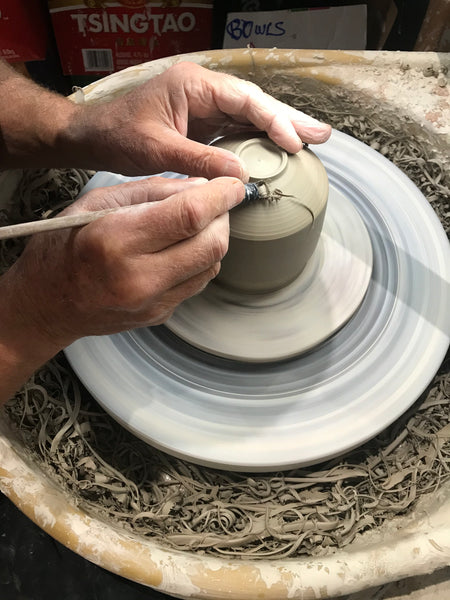
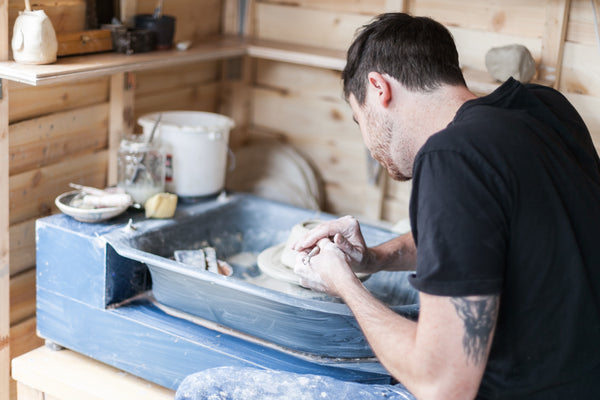
Daniel Woodsmith
Posted by Clare Grennan in: Irish Ceramics, Irish Craft, Irish maker story, maker story

Tell us a little bit about what you make:
I make a variety of tableware using both stoneware clay and more recently, local clay from the Dublin mountains. Each piece is hand thrown in my studio in Shankill and glazed using a variety of bought glazes and again, more recently, my own glaze recipes. The glaze tones I generally use are quite earthy and minimal.
Could you describe your studio to us? What is your favourite thing about the space and how do you get into the mindset of making?
My studio is an 8foot by 8foot lean-to shed in my garden which I bought last Summer. I built the internal worktops etc. myself. This was an upgrade from the ……shed I was squeezing into prior to that. My favourite thing about the space is the light, I added an extra window just before the Summer of this year and having the brightness and view of the sky as I sit at my wheel helps my creativity. To get into the mindset of making I think that the music I listen to really helps me to focus, listening to music while staring at a spinning wheel is hypnotic and really pulls me into my craft. The ever-growing number of shelves which I have built in my studio gives me that added burst of motivation to fill them with new creations.

What is your favourite tool and why?
When I started pottery last April I made all of my tools from items around my house, and since I have progressed further, some of these tools have been upgraded to bought pottery tools created for the craft, however my favourite tool to use is still an old kitchen steak knife which, having tried and tested many other tools at this stage, never fails and just feels right in my hand.
Can you describe the making process and inspiration behind your local clay bowls?
I dug the local clay from the Dublin mountains, about 20 minutes’ drive from where I live in Shankill. It’s quite a labour-intensive process which includes breaking it down, sieving it several times, washing it twice, drying it, and finally wedging it (kneading it), from there it can finally be thrown, dried, trimmed, bisque’d in the kiln for 19 hours, waxed, glazed, and fired again for 19 hours!
The inspiration behind my clay bowls was to firstly keep it local, to have handmade Irish ceramics made from hand-dug Irish clay! I think that these products are really beautiful in that they let the natural surface speak for themselves, the minerals in the clay also cause a change in the glazes used as the natural compounds seep into the glazes which is something I find really exciting!

What led you to choose this craft as a profession? What do you love most about it? What do you dislike?
I’ve been making ceramics for little over a year now. I was a chef for 12 years and I have always had an interest and passion for ceramics, after returning from traveling for 2 years around South America and Australia I decided to buy some clay one day and have a go, from there I decided I liked it and to take a break from cooking professionally and focus on making pottery and it all has kicked off since then.
What I love most about what I do is that I’m making something that can last forever, we all have a favourite mug or a something that reminds us of a time or a person who gave it to us, I like the idea that something I make could be passed down and looked after “remember when we got those mugs in Ireland”, I think that’s kind of special.
What I dislike about this craft, at the moment, is that I’m used to working as part of a team and at the moment I spend a lot of time by myself, which is not necessarily a bad thing but it’s quite different for me, I could see myself possibly working in a collective studio of some variety in the future.
-Images by Alex Louviers
You can purchase a selection of Daniel's work here.
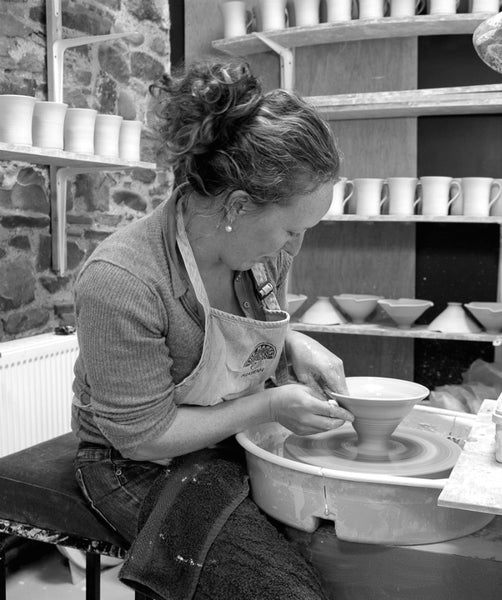
Rosemarie Durr - Irish Potter
Posted by Anna Crudge in: Handmade, Irish Ceramics, Kilkenny, Pottery

Tell us a little bit about what you make
I make a range of hand-thrown tableware, made from Stoneware clay that are designed for everyday use.
Could you describe your studio to us? What is your favorite thing about the space and how do you get into the mindset of making?
At the moment I work between two studios. Both of which I share with my husband Ceramic artist Andrew Ludick. Our studio and shop in Castlecomer Discovery Park and the studio we built at home (4 miles outside Castlecomer) since the kids came along. We split our time between the two so one of us can be home with the children. The studio/shop in the Discovery Park is a converted stable dating back to the seventeen hundreds with exposed stone walls and a red brick floor and our studio at home is a modern wooden structure with plenty of light. Both spaces are great to work in. I love the warm bright feeling I get from our home studio and in our shop/studio, I like being in a space where I'm away from the children and I can focus more on getting work done. So these days the only mindset I need to get into to make is a quite space away from little people.
What is your favorite tool and why? Where do your tools come from?
I have gathered many tools over the years but actually only use three or four on a regular basis. The one I use in the making of every pot is a plastic kidney (it's shaped like a kidney hence the name) I use it to smooth and shape the outside of my pots before I take them off the wheel and I made it myself from the lids of the catering buckets of mayonnaise. I've been making them for nearly 20 years and find that the Hellman's mayonnaise catering bucket lid is the perfect strength of plastic. I also have a porcupine quill which I got from a famous American potter Warren MacKenzie many years ago (he is over 90 now and still making pots) that is an amazing tool for putting holes in teapots among other things and a joy to use. I've since bought more from America as they do wear out after a while.

Can you describe the making process and inspiration behind your work?
Throwing the pots is actually the fastest part of the process it's all the other parts that take time. I weigh out the clay so each cup, bowl, etc. Is the same weight of clay and for my stacking range I set a pointer to make sure each pot is the same size. With my other ranges, I don't do this so these pots are a little more organic. With the stacking range, they need to be exact so they stack neatly. I then let the pots dry for a day or so (depending on the weather) then trim and stamp the bottoms and it's at this stage I add handles if required. After a week or so drying, they are bisque fired up to 1000 degrees C. They come out white, strong enough to handle easily and porous, it's at this stage I glaze them by dipping them into a large bucket of glaze and wiping the bottoms clean then they go back into the kiln and are fired up to 1290 degrees C. This firing takes 12 hours and then a further 24 hours before the kiln is cool enough to open. Then the pots either get packaged up to go out to shops or brought the short distance from the kiln shed to our shop.
I love to make pots. I love the physical act of throwing. I love the challenge of throwing pots that are uniform and exact in a short space of time. It's the joy of cooking and using pots in everyday life that inspire my designs. Function is an important aspect of my work, simple shapes that work well. We live up the hills and on walks along our quiet country road you go from hedgerows to pine forest to hill top views with the vast expanse of fields, distant mountains and big, big skies. All of these things soak into my work.
What led you to choosing this craft as a profession? What do you love most about it?
I studied Graphic Design for a couple of years after leaving school and following that I took up a night class in pottery while working in Dublin, this was the first time I worked with clay and I loved it straight away. I applied for and got accepted to Grennan Mill craft school and following that the DCCOI Pottery Skills course in Thomastown. That was twenty-three years ago and I have never looked back. I trained as a production thrower, so I'm happiest at the wheel. I am completely at ease while throwing pots and count myself very fortunate to call it my Job.
You can purchase Rosemarie's stacking collection both online and from our Drury street location.

Helen Faulkner - Process & Planters
Posted by Anna Crudge in: Áras, Down Arts Centre, handmade, Helen Faulkner
We have been fans of Helen Faulkner's work for some time now, the contrast between the dark terracotta clay and the creamy coloured glazes she uses is very appealing. We were delighted when she agreed to create a range of plant pots for Áras, our new collection of home wares. We interrupted the production of our new plant pots with a few questions about what inspires her work and how it is made.

How did you first get into working with clay?
I was introduced to clay during a foundation art course but the first time I got to trying throwing on the potters wheel was a couple of years later on my Contemporary Craft Degree in England and from then on it was all I wanted to do.
What inspires the shapes and colours of your pieces?
My inspiration comes from how the pots are going to be used. I love cooking and eating! So my tableware range is all about food, a smooth curve on the base of a mug that rests comfortably in the hand or thinking about what colours the food will look great on, such as a leafy green salad in a bright blue bowl.
You have designed a collection of plant pots for us, what was the most challenging aspect of the project? what was the most enjoyable?
Making a final decision on decoration was hard, throughout the design process I go through so many ideas that it can be hard to settle on just one. I really enjoyed going through the design ideas sent sent through by yourselves, trying to pull out the most important aspects of the design to you and bringing them together with my style and ideas, it's a challenge I enjoy!

What sort of plants do you envisage people putting in the pots? Did you have something specific in mind when designing/prototyping?
With the tall pot I can imagine spider plants, the stripy leaves that droop down would be a great contrast against the rich red clay. I can imagine mini cactus in the shallow pot but something a bit more useful would be an aloe vera plant. A row of tall plant pots would also look great in the kitchen with herbs in them, again I just can't help but bring it back to food!
Are you currently working on any other new/exciting projects?
I'm working towards a group exhibition that's happening in Down Arts Centre where I have my studio, it's part of August Craft Month in Northern Ireland that is a month long collection of events celebrating crafts, lots of workshops and talks happening too.
What is the greatest and worst part of being self employed?
The best part of being self employed, aside from making pots every week, is the control over my working life and deciding what is important for me. The hardest part of being self employed is nearly the same thing, having to control every aspect is a massive juggling act and sometimes I mess it up but it's all learning so I just start again the next day!
Finally, what do you most like to do on your days off? Do you give yourself days off?
I spend my spare time cooking, I love spending time in the kitchen although I usually end up with a lot of dishes to do because I like to use all the pots I’ve collected over the years! My dog Sheva, who spends her days in the studio with me keeping an eye on things, takes up the rest of my day with walks.
Click here to shop some of Helen's fabulous pots and planters made exclusively for the Irish Design Shop ARAS collection.


Dunbeacon Pottery
Posted by Clare Grennan in: Dunbeacon Pottery, Durrus, Irish Ceramics, Tableware

On a sunny Sunday morning in late August, we arrived into the picturesque West Cork village of Durrus. Pinned to the doors of a closed local shop hung some twenty plastic carrier bags. On closer inspection, we realised each bag was marked with a customers name and contained their Sunday Newspaper. Not exactly astonishing, but surprising all the same, particularly to a couple of Dubs who can’t believe these bags haven’t been nicked.
West Cork is renowned for its strong sense of community. Durrus is situated on the Sheeps Head peninsula, and consists of a tiny main street lined with overflowing hanging baskets. The lure of a small community coupled with stunning scenery has enticed many to settle in pretty West Cork villages such as Durrus for decades now. Dublin native Helen Ennis is one such visitor who decided to make this quaint part of the country her home.

In 2000, Helen took over the running of Dunbeacon Pottery following many years apprenticing for potters all over Ireland. In the past 14 years, she has built a loyal customer base with her brand of hand made, functional ceramics.
Helen’s studio and showroom, which overlooks her beautifully maintained garden and out to the sea, is open to visitors six days a week. Over a cup of coffee, we discussed life in West Cork, Helen’s design and making process and best places to eat in the area! …….
Can you tell us a little about the making process?
Firstly, I process the clay, then, in order: throwing, turning, applying handles if necessary, bisc firing, glazing and finally glaze firing. The entire process can take up to 2 weeks to complete.
Do you have any new ranges and or products in the pipeline?
At the moment I am happy working on the ranges I currently produce, my customers obviously like them too as they are selling well. While I always have ideas for other ranges in the back of my mind for now I am happy to work at what I do. I am going to the States next week and am looking forward to visiting ceramics galleries as well as some studios too hopefully.
Being self employed has its challenges, what are the best and worst bits?
Being self employed is great in that I have control over each aspect of production, on the downside I am the only one to blame when any such aspect goes wrong!
How do you like to switch off from the pottery business?
For down time from the pottery there is plenty of walking to do in the area. But mostly I enjoy spending time with friends. The wealth of friendships that I have built up in west Cork is integral to living in this area for me. Recently, we have been doing a shared gardening group where we go to to a friends garden as a group and get some bigger jobs done, its a good social opportunity as well as getting some garden chores done!
I also enjoy going for a drink in Levis' pub Ballydehob, there will often be some kind of session on there at the weekend
Finally, West Cork is renowned for artisan food production, where are your favourite foodie spots in the area?
For food I like The Stuffed Olive and Organico in Bantry, Good Things Cafe in Durrus usually has interesting locally sourced delicious food. For the best (and probably biggest!) scones in west Cork I will go to Jims Coffe Shop in Glengarriff. Picnic supplies will come from Mannings in Ballylickey or a local farmers market.


